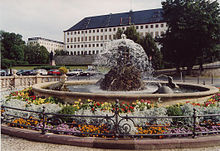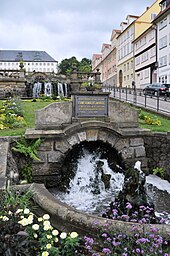Water art Gotha
The water art Gotha is a system completed in 1895 for irrigation of wells and fountains as well as for the local water supply and at the same time a sight in the historic old town of Gotha .
history
With the growing population and in view of the frequent fires, the municipal wells no longer met the requirements, so that the Leina Canal was built in the 15th century , which covers a distance of approx. 30 km and with an altitude difference of 101 m the city supplied water from the Thuringian Forest . A wooden pumping station in the city was able to transport the water to Friedenstein Castle . Over the years, this resulted in an extensive pipeline system for the water supply of the ducal facilities, buildings, apartments, ponds and wells.
The Leina Canal water also operated numerous mills and flowed through the middle of the city. There, at the upper end of the main market, directly below the castle, the mountain mill on the Schlossberg has stood since 1387 .
Since the middle of the 19th century, the stock corporation for the water supply of the city of Gotha has been transporting spring water from the Mittelwassergrund (south of Tambach-Dietharz ) to an elevated tank on the Hirzberg between Wipperoda and Wannigsroda and in a closed pipe to Gotha. Hugo Mairich began planning the redesign of the Schlossberg and the construction of the water art and the pumping station as early as 1890. His plans envisaged a system that would lead the water of the Leina Canal via fountains, fountains, waterfalls and whirlpools from the castle to the main market.
After the mountain mill there was demolished in May 1895, the new water art (water features) was built from its stones and inaugurated on October 15, 1895. The new pumping station (Neue Wasserkunst) in the basement of the Lucas Cranach House is still in operation today. In 1995 the Gothaer Wasserkunst (pumping system and water features) was reconstructed on the 100th anniversary of its construction in 1895.
Today, the lovingly designed complex is essentially a three-part water feature and fountain that has been one of the city's most important sights since it was built. It is not in operation in the winter months. The opening ceremony takes place on the first weekend in May on the occasion of the Gothardus Festival .
description
The water flows from the fountain on Friedrich-Jacobs-Straße towards NNW over three levels with a length of about 72 m. The water falls over a waterfall into the next level with several identical ponds at different heights. The water is then led under a short cul-de-sac to the lower part. Here a memorial plaque from 1869 commemorates the 500th anniversary of the line from the Leinawasser to Gotha .
Historic pumping station of the Neue Wasserkunst Gotha and exhibition on the Leinakanal in the Gotha Lucas-Cranach-Haus
The “Lucas-Cranach-Haus” is located on the upper main market (Markt 17) in Gotha.
History of the Lucas Cranach House
The two-storey baroque building replaces a building that once belonged to the Renaissance painter Lucas-Cranach the Elder (1472–1553). He married Barbara Brengbier in 1504 , whose father, the Gotha councilor Jost Brengbier , owned this property. Later the house passed into the ownership of Lucas Cranach the Elder by inheritance. Of this building, however, only the basement with its beautiful cross vault, the portal with heraldic plaques and a house sign are original. In 1553 Georg Dasch inherited the house. The von Wangenheim family later became the owners. The current building is from the time after 1632 (great fire in Gotha). The portal shows the coat of arms of the Dasch (a bag) and Cranach (winged snake) families. In 1853 the “Höhere Töchter Schule Gotha” was located in the building. From 1852 to 1986 it was used as a school. The building has belonged to the city of Gotha since 1854 and is now used for various events and exhibitions. Since 1872 (Cranach's 400th birthday) it has been called the "Lucas-Cranach House". An exhibition on the history of the Leinakanal and Gotha water art (pumping system and water features) is currently being shown in the building .
History of the Neue Wasserkunst -Pumpwerk Gothas- in the Lucas-Cranach-Haus
After an old water art (pumping system) had existed in Gotha since the 15th century, which pumped water from the Leina Canal up to the Gothaer Schloßberg , a “New Water Art” (pumping station) was installed in the basement of the Cranach House by engineer Hugo Mairich in 1895 . The suggestion for this was made by Hugo Mairich in 1890. The Gothaer Maschinenfabrik Briegleb & Hansen (see: August Briegleb (1840–1924) and Wilhelm Hansen ) installed a pump and turbine system in the basement of the Lucas-Cranach house to operate the fountain and to generate electricity. A turbine uses the water from the Leinakanal to drive a generator to generate electricity and additional pumps that still pump the water up to the Schloßberg today. The system in the basement of the building is still in operation today and feeds the fountains and water features in Gotha. In 1995 the pump system including the water art was restored. It can be visited.
See also
literature
- Freundeskreis Leinakanal eV: Brochure Der Leinakanal - A lobby for the (very) old rascal , Gotha, 2017, with information on water art in Gotha
- Albert Doell: Gotha and its water. With a sketch map of the Leina Canal and the raft ditch. Published by the Gotha City Council. Engelhard-Reyher, Gotha 1922.
- Karl Kohlstock : Voyages of Discovery at Home. Volume 8: The main line of the Leinakanal in the city of Gotha (= voyages of discovery in the homeland. 8). 2nd, increased edition. Self-published by the author, Gotha 1926.
- Rudolf Umbreit: The development of the city of Gotha from the founding of the empire to the overthrow. - In: Kurt Schmidt (Ed.): Gotha. The book of a German city. Volume 1. Engelhard-Reyher, Gotha 1931, pp. 255–308, especially p. 261 (supply and disposal of water).
- Gotha ennobles, travel planner Gotha 2018/19, From Baroque to Modern, the residential city of Gotha invites you , Cranach House and Pumpwerk p. 15, Wasserkunst am Schlossberg p. 14, publisher: KulTourStadt Gotha GmbH, 2017
Web links
- Water Art gotha.de,
- The civil engineer Hugo Mairich - From his life and work on the website of the Freundeskreis Leinakanal eV, accessed on July 19, 2016
Individual evidence
- ↑ Freundeskreis Leinakanal eV: Brochure Der Leinakanal - A lobby for the (very) old rascal , Gotha, 2017, Chronology of the Leinakanal system p. 3
- ↑ Gotha adelt, Travel Planner Gotha 2018/19, From Baroque to Modern, the residential city of Gotha invites you, Cranach House and Pump Station p. 15, KulTourStadt Gotha GmbH, 2017
- ↑ Freundeskreis Leinakanal eV: Brochure Der Leinakanal - A lobby for the (very) old rascal , Gotha, 2017




